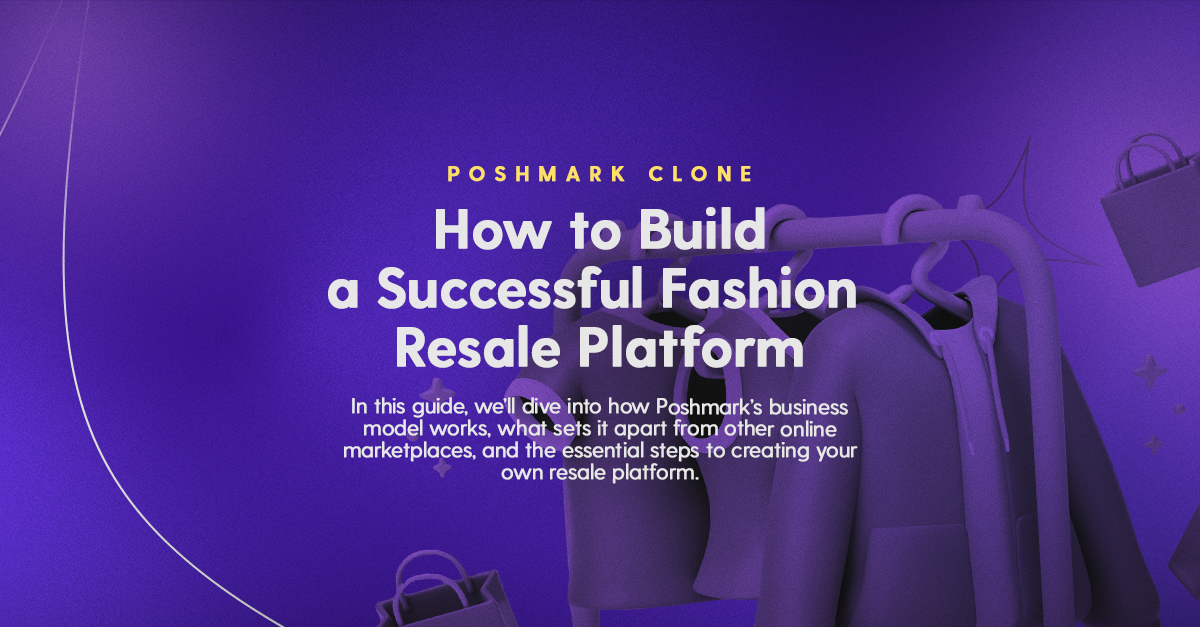Poshmark is not just another e-commerce platform — it has revolutionized the way people buy and sell secondhand fashion. Unlike traditional online retailers that focus on mass-produced products, Poshmark thrives on peer-to-peer selling, making it easy for individuals to list, discover, and purchase pre-owned clothing, shoes, and accessories. This community-driven approach has made it a go-to marketplace for fashion lovers looking to declutter their closets, find great deals, or even build small resale businesses.
The journey of Poshmark began in 2011, when Manish Chandra, Tracy Sun, Gautam Golwala, and Chetan Pungaliya recognized a gap in the online shopping experience. While platforms like eBay and Craigslist enabled secondhand sales, they lacked the simplicity, social engagement, and trust that buyers and sellers craved. Poshmark set out to bridge that gap, launching a mobile-first marketplace that felt more like a social network for fashion than a traditional online store.
At the heart of Poshmark’s success is its effortless selling experience. Unlike other resale platforms that require complex listing processes or negotiations, Poshmark enables users to snap a photo, upload a listing, and set a price in just a few clicks. Sellers don’t need to worry about payment processing or shipping logistics — Poshmark handles it all, providing prepaid shipping labels and secure transactions to make the process seamless. This ease of use has attracted millions of casual sellers, many of whom start by selling items from their own wardrobes before scaling into full-time resale businesses.
But Poshmark isn’t just about buying and selling — it’s about community and engagement. The platform allows users to follow their favorite sellers, share listings, join themed “Posh Parties,” and interact through likes and comments, creating an experience that mimics social media. This social-driven shopping experience has been a game-changer, leading to higher engagement, increased sales, and a sense of connection between buyers and sellers.
Today, Poshmark boasts over 100 million registered users, making it one of the largest online fashion resale platforms in the world. With billions of dollars in transactions and a growing seller base, the platform has expanded beyond just clothes and accessories, now offering home decor, beauty products, and pet items. As sustainability and circular fashion trends continue to rise, Poshmark remains at the forefront of the resale industry, proving that secondhand shopping is not just a passing trend — it’s the future of fashion.
Why Poshmark Stands Out from Other Marketplaces
The online resale market is crowded, with platforms like eBay, Depop, ThredUp, and Facebook Marketplace all offering ways to buy and sell secondhand fashion. However, Poshmark has managed to carve out a unique space, blending e-commerce with social engagement to create a platform that is more than just a place to shop — it’s a community.
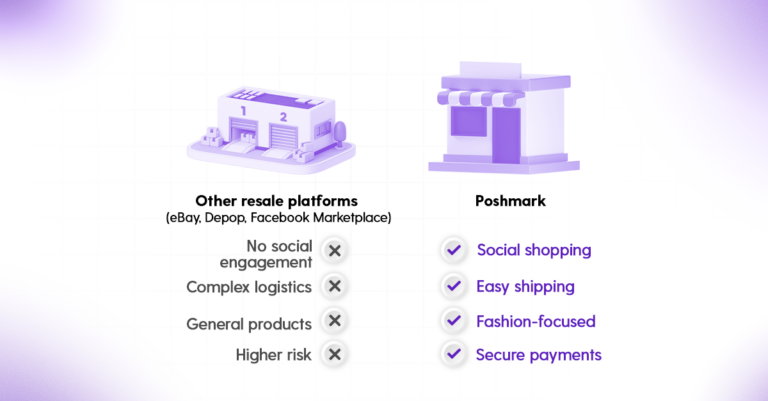
A Social Shopping Experience Like No Other
One of Poshmark’s biggest differentiators is its social-driven shopping model. Unlike traditional marketplaces where transactions are purely transactional, Poshmark encourages interaction. Users can follow their favorite sellers, like listings, leave comments, and even negotiate prices directly. This level of engagement makes shopping feel more personal and interactive, much like browsing through a friend’s curated closet rather than a massive online store.
Another standout feature is Posh Parties — real-time, themed shopping events where users can share and promote their listings. Whether it’s a designer bag sale or an athleisure event, these parties create excitement and help sellers gain more visibility for their items. No other marketplace has integrated real-time social selling at this scale, making Poshmark feel as much like a fashion network as an e-commerce platform.
The Simplicity of Selling on Poshmark
Selling on many platforms can be a hassle, requiring sellers to manage their own shipping, customer communication, and even disputes. Poshmark eliminates much of this stress by streamlining the process. Once a seller makes a sale, they receive a prepaid, pre-addressed shipping label to send their item off quickly and easily. There’s no need to calculate shipping rates or handle logistics — Poshmark takes care of it.
This ease of selling attracts casual users who are simply decluttering their closets, as well as full-time resellers who operate virtual boutiques. Whether someone is selling a single designer handbag or an entire inventory of thrifted finds, Poshmark makes the process seamless.
A Fashion-Only Focus That Attracts the Right Buyers
While competitors like eBay and Facebook Marketplace allow users to sell everything from electronics to furniture, Poshmark stays laser-focused on fashion. This specialization means that buyers know exactly what to expect when they log in: a curated selection of clothing, shoes, accessories, and beauty products.
This focus creates a dedicated, fashion-forward audience. Unlike general resale sites where users might have to sift through thousands of unrelated listings, Poshmark ensures that buyers see only relevant, fashion-related items. For sellers, this means access to an audience that is specifically looking for clothing and accessories — leading to faster sales and more engaged buyers.
Security and Trust in Every Transaction
One of the biggest concerns with peer-to-peer marketplaces is trust. Many buyers are wary of scams, counterfeit products, or sellers who don’t ship their items. Poshmark provides built-in protection to make transactions feel safer:
- Buyer Protection Guarantee: Funds are only released to the seller once the buyer confirms they received the item as described.
- Authentication for Luxury Items: High-end purchases, like designer handbags, go through a verification process to ensure authenticity.
- Secure Payments: Unlike platforms where payments can be handled offsite (leading to scams), Poshmark keeps everything within its own system to prevent fraud.
This level of security makes Poshmark a trusted marketplace, allowing users to shop and sell with confidence — something that is often lacking in platforms like Facebook Marketplace or Craigslist.
The Opportunity to Scale from Side Hustle to Business
Many sellers start using Poshmark as a way to declutter their closets and earn extra cash, but for some, it evolves into a full-time business. The platform provides a range of seller tools, including:
- Inventory management features to track sales and listings.
- Branding options like customizable storefronts and marketing tools.
- Seller analytics to track performance and improve sales strategies.
Some sellers go from making a few sales a month to running full-fledged resale businesses, thanks to Poshmark’s scalable infrastructure. The combination of a built-in audience, marketing tools, and shipping solutions makes it an attractive platform for aspiring entrepreneurs in the resale fashion industry.
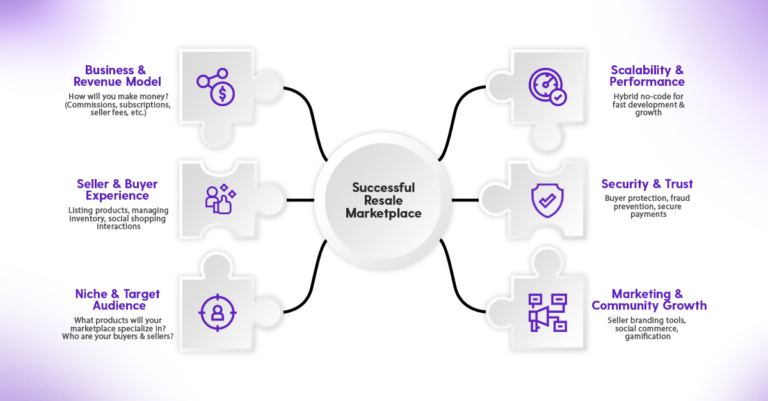
Poshmark’s Unique Formula for Success
By blending social interaction, simplified selling, and a curated fashion focus, Poshmark has positioned itself as a leading marketplace in the resale industry. Unlike competitors that rely purely on listings and transactions, Poshmark has built an engaged community where shopping feels personal, safe, and fun.
For anyone looking to create a resale marketplace like Poshmark, understanding these core differentiators is crucial. It’s not just about facilitating transactions — it’s about fostering a thriving community, simplifying the selling process, and ensuring trust between buyers and sellers. That’s the magic of Poshmark, and why its model continues to thrive in the competitive world of online fashion resale.
How Poshmark’s Marketplace Works
At its core, Poshmark is a peer-to-peer resale platform, allowing individuals to list fashion items for sale while buyers browse, purchase, and have items shipped directly to them. However, what sets Poshmark apart is its seamless user experience, built-in logistics, and community-driven engagement — all designed to make selling secondhand fashion as effortless as possible.
Unlike traditional online marketplaces where sellers must handle everything from marketing to shipping, Poshmark simplifies the process with built-in tools that remove the typical friction associated with reselling.
Listing an item takes minutes — sellers simply upload images, write a description, and set their price. There’s no need to worry about calculating shipping fees or negotiating payment logistics. Once a sale is made, Poshmark provides a prepaid shipping label, making it easy for sellers to pack and send their items without hassle.
From a business perspective, Poshmark’s revenue model is also simple yet effective. The platform charges a flat fee of $2.95 on sales under $15 and takes a 20% commission on sales over $15. This structure allows casual sellers to list their items for free while ensuring that Poshmark remains profitable as sellers scale their businesses.
Another key factor in Poshmark’s success is buyer protection. Unlike marketplaces where trust issues can deter transactions, Poshmark holds funds in escrow until the buyer confirms receipt of the item. This ensures that sellers get paid only when the transaction is completed smoothly, fostering a sense of security for both buyers and sellers.
This combination of ease, security, and built-in logistics has propelled Poshmark into a billion-dollar marketplace, making it accessible to both part-time sellers looking to declutter and full-time entrepreneurs building fashion resale businesses.
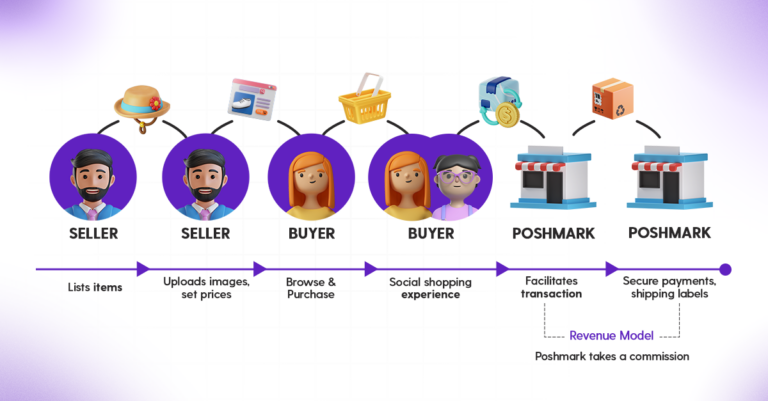
Who Uses Poshmark? Understanding the Buyer & Seller Community
Poshmark has built a diverse and highly engaged user base, making it a go-to platform for anyone interested in fashion resale. The marketplace isn’t just for one type of user—it attracts shoppers and sellers with different motivations, all coming together under a shared appreciation for affordable, stylish, and sustainable fashion.
Fashion Lovers & Bargain Hunters
Many shoppers come to Poshmark looking for discounted designer brands, rare finds, and trendy items at a fraction of retail prices. With thousands of listings added daily, it’s a treasure trove for those who love the thrill of discovering great deals on high-end fashion.
Eco-Conscious Consumers
Sustainability is a growing priority in fashion, and Poshmark has become a hub for secondhand shopping. Buying pre-owned clothing reduces waste and extends the life cycle of garments, making it a greener alternative to fast fashion. Many buyers turn to Poshmark as a way to shop more sustainably without compromising on style.
Small Business Owners & Resellers
While some sellers start out by listing clothes from their own closets, many quickly scale into full-time reselling businesses. Some source inventory from thrift stores, outlet sales, or liquidation stock to build a dedicated resale brand. Poshmark supports these power sellers with analytics, promotional tools, and branding options, allowing them to grow beyond just casual selling.
Poshmark’s ability to blend affordability, sustainability, and business potential is what makes it so appealing. Whether users are looking to save money, make money, or reduce their environmental impact, Poshmark offers an all-in-one platform that keeps buyers and sellers engaged.
How to Build a Marketplace Like Poshmark
Creating a resale marketplace like Poshmark requires more than just a website — it demands a strong business model, an engaging user experience, and scalable technology to support buyers and sellers at every step. If you’re looking to launch your own fashion resale platform, you’ll need to focus on key aspects such as niche selection, monetization, user engagement, and platform functionality.
While Poshmark has built its success around secondhand fashion, the same marketplace structure can be applied to luxury resale, electronics, collectibles, or even digital goods. Whether you want to replicate Poshmark’s social shopping model or introduce a unique twist, here’s what it takes to build a thriving peer-to-peer marketplace.
Finding Your Niche: Defining Your Marketplace Identity
Before you start developing your platform, you need to define your niche. Poshmark succeeded because it focused solely on fashion and personal accessories, attracting a specific group of buyers and sellers who share a passion for style and affordability.
If you want to build a Poshmark clone or a similar marketplace, ask yourself:
- Will your platform specialize in a single category, like fashion, or expand into broader resale markets?
- Are you targeting luxury resale, thrift shopping, or mainstream secondhand items?
- How will you differentiate your marketplace from competitors like Depop, ThredUp, and eBay?
A well-defined niche helps create brand recognition and loyal users, ensuring your marketplace doesn’t get lost in a sea of generic e-commerce platforms.
Choosing a Monetization Model That Works
Every marketplace needs a way to generate revenue. Poshmark makes money through transaction fees, charging a flat rate of $2.95 on sales under $15 and taking a 20% commission on sales over $15. However, different marketplaces use various monetization strategies, such as:
- Subscription-based models, where sellers pay a monthly fee for premium access.
- Listing fees, where sellers pay per item they upload.
- Advertising revenue, where sellers can boost their listings for more visibility.
When launching a marketplace like Poshmark, you need to choose a monetization model that balances affordability for sellers while ensuring steady platform growth.
Crafting an Engaging User Experience
One of Poshmark’s biggest strengths is its mobile-friendly and social-driven interface, making buying and selling fashion effortless. If you want to launch a marketplace that competes with Poshmark, your platform should prioritize:
- Easy seller onboarding, allowing users to quickly list products with photos, descriptions, and pricing.
- Intuitive search and filtering, helping buyers find exactly what they’re looking for.
- Optimized mobile performance, since the majority of Poshmark users shop through mobile devices.
A seamless user experience ensures high engagement, increased conversions, and long-term marketplace retention.
Essential Features for a Successful Marketplace
If you’re developing a Poshmark clone script or building a resale platform from scratch, you’ll need a set of core features that cater to both buyers and sellers. These include:
- User profiles & seller storefronts, allowing sellers to showcase their products and build a brand.
- Secure payment processing, ensuring safe transactions through trusted gateways.
- Social engagement features, enabling users to share listings, follow sellers, and interact within the marketplace.
- Automated shipping tools, simplifying the logistics for sellers.
- Ratings & reviews, fostering trust within the community.
These features are essential for scaling your platform while maintaining a high-quality marketplace experience.
Building a Community-Driven Platform
Poshmark isn’t just a resale site — it’s a social marketplace where users actively engage with each other. The platform’s success is largely driven by community-building efforts, such as:
- Posh Parties, where users can showcase listings in real-time.
- Buyer-seller messaging, allowing direct communication and negotiation.
- Social sharing tools, increasing product visibility and engagement.
To build a Poshmark-like marketplace, your platform should encourage interactions, trust, and a sense of community, making shopping and selling feel more personal.
Choosing the Right Technology for Scalability
Your platform needs scalability, security, and seamless functionality to handle increasing users and transactions. Many marketplace founders struggle with development costs and technical limitations, which is why low-code and no-code platforms like Dittofi offer a smarter solution.
With Dittofi’s scalable infrastructure, you can:
- Launch faster without heavy development costs.
- Customize features to match your business needs.
- Ensure seamless performance and security as your marketplace grows.
By leveraging the right technology, you can future-proof your marketplace, ensuring long-term success in the resale industry.
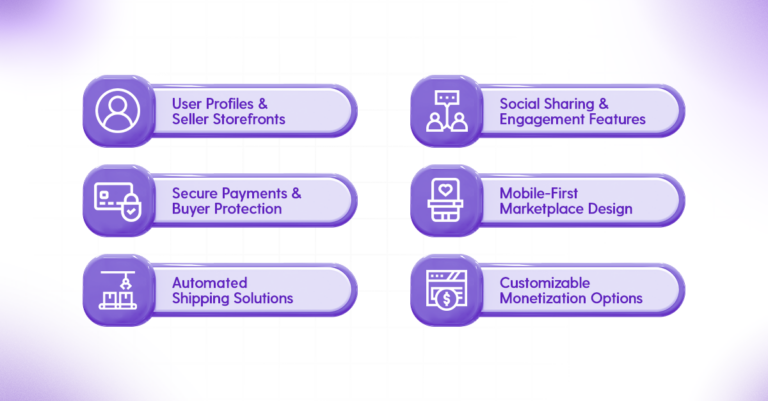
Final Thoughts: Turning Your Marketplace Idea into Reality
Poshmark’s growth into a billion-dollar resale marketplace proves that peer-to-peer shopping platforms have massive potential. However, launching a successful marketplace requires careful planning, smart monetization, and the right technology to support sellers and buyers at scale.
Whether you’re looking to clone Poshmark’s model or build a unique resale platform, the key to success is combining seamless user experience, strong community engagement, and scalable infrastructure.
Ready to bring your marketplace idea to life? Start building today with Dittofi and create the next big resale platform.
Choose the Right Technology for Scalability
Technology can make or break your resale marketplace. Learn how to choose the best infrastructure for seamless scaling.

